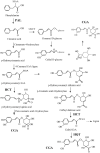The Biological Activity Mechanism of Chlorogenic Acid and Its Applications in Food Industry: A Review
- PMID: 35845802
- PMCID: PMC9278960
- DOI: 10.3389/fnut.2022.943911
The Biological Activity Mechanism of Chlorogenic Acid and Its Applications in Food Industry: A Review
Abstract
Chlorogenic acid (CGA), also known as coffee tannic acid and 3-caffeoylquinic acid, is a water-soluble polyphenolic phenylacrylate compound produced by plants through the shikimic acid pathway during aerobic respiration. CGA is widely found in higher dicotyledonous plants, ferns, and many Chinese medicine plants, which enjoy the reputation of "plant gold." We have summarized the biological activities of CGA, which are mainly shown as anti-oxidant, liver and kidney protection, anti-bacterial, anti-tumor, regulation of glucose metabolism and lipid metabolism, anti-inflammatory, protection of the nervous system, and action on blood vessels. We further determined the main applications of CGA in the food industry, including food additives, food storage, food composition modification, food packaging materials, functional food materials, and prebiotics. With a view to the theoretical improvement of CGA, biological activity mechanism, and subsequent development and utilization provide reference and scientific basis.
Keywords: bioavailability; biosynthesis pathway; chlorogenic acid; food application; mechanism; source.
Copyright © 2022 Wang, Pan, Jiang, Chu, Gao, Jiang, Zhang, Chen, Luo and Peng.
Conflict of interest statement
The authors declare that the research was conducted in the absence of any commercial or financial relationships that could be construed as a potential conflict of interest.
Figures







Similar articles
-
Bioactive functions of chlorogenic acid and its research progress in pig industry.J Anim Physiol Anim Nutr (Berl). 2024 Mar;108(2):439-450. doi: 10.1111/jpn.13905. Epub 2023 Nov 17. J Anim Physiol Anim Nutr (Berl). 2024. PMID: 37975278 Review.
-
Unleashing the power of chlorogenic acid: exploring its potential in nutrition delivery and the food industry.Food Funct. 2024 May 7;15(9):4741-4762. doi: 10.1039/d4fo00059e. Food Funct. 2024. PMID: 38629635 Review.
-
Chlorogenic acid (CGA): A pharmacological review and call for further research.Biomed Pharmacother. 2018 Jan;97:67-74. doi: 10.1016/j.biopha.2017.10.064. Epub 2017 Nov 6. Biomed Pharmacother. 2018. PMID: 29080460 Review.
-
A Review on Electrochemical Sensors and Biosensors Used in Chlorogenic Acid Electroanalysis.Int J Mol Sci. 2021 Dec 5;22(23):13138. doi: 10.3390/ijms222313138. Int J Mol Sci. 2021. PMID: 34884943 Free PMC article. Review.
-
[Advances of study on glucose and lipids metabolism of chlorogenic acid regulating].Wei Sheng Yan Jiu. 2008 Sep;37(5):637-9. Wei Sheng Yan Jiu. 2008. PMID: 19069672 Review. Chinese.
Cited by
-
Effect of green coffee on miR-133a, miR-155 and inflammatory biomarkers in obese individuals.Diabetol Metab Syndr. 2024 Oct 28;16(1):256. doi: 10.1186/s13098-024-01478-7. Diabetol Metab Syndr. 2024. PMID: 39468643 Free PMC article.
-
Physicochemical Properties, Stability, and Functionality of Non-Covalent Ternary Complexes Fabricated with Pea Protein, Hyaluronic Acid and Chlorogenic Acid.Foods. 2024 Jun 27;13(13):2054. doi: 10.3390/foods13132054. Foods. 2024. PMID: 38998558 Free PMC article.
-
Recent Updates on the Therapeutics Benefits, Clinical Trials, and Novel Delivery Systems of Chlorogenic Acid for the Management of Diseases with a Special Emphasis on Ulcerative Colitis.Curr Pharm Des. 2024;30(6):420-439. doi: 10.2174/0113816128295753240129074035. Curr Pharm Des. 2024. PMID: 38299405 Review.
-
Chlorogenic acid induces apoptosis and cell-cycle arrest in colorectal cancer cells.Mol Biol Rep. 2023 Dec;50(12):9845-9857. doi: 10.1007/s11033-023-08854-y. Epub 2023 Oct 17. Mol Biol Rep. 2023. PMID: 37847443
-
Comprehensive phytochemical characterization of Persea americana Mill. fruit via UPLC/HR-ESI-MS/MS and anti-arthritic evaluation using adjuvant-induced arthritis model.Inflammopharmacology. 2023 Dec;31(6):3243-3262. doi: 10.1007/s10787-023-01365-z. Epub 2023 Nov 7. Inflammopharmacology. 2023. PMID: 37936023 Free PMC article.
References
Publication types
LinkOut - more resources
Full Text Sources
Research Materials

